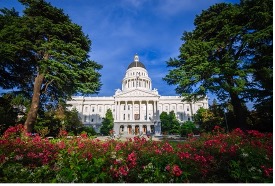AB 2247 Advances, State Legislative Committee to Meet Next Week
CASA is pleased to share that our co-sponsored bill, AB 2247 (Bloom) was heard in the Assembly Environmental Safety and Toxic Materials Committee last week and passed. The bill, which requires manufacturers to disclose PFAS in their products on a publicly accessible database, now advances to the Assembly Appropriations Committee. Several other bills CASA is tracking also advanced and will be discussed at the next State Legislative Committee meeting on May 13.
Senate Budget Plan Released
 Last week, the Senate released its Budget plan in advance of the Governor’s May Revise being released. There is some good news in the revise for wastewater agencies, although some of the details about their funding priorities are sparse. The entire plan can be viewed here. There are several key takeaways of interest, including:
Last week, the Senate released its Budget plan in advance of the Governor’s May Revise being released. There is some good news in the revise for wastewater agencies, although some of the details about their funding priorities are sparse. The entire plan can be viewed here. There are several key takeaways of interest, including:
- A $68 billion surplus which they propose to allocate to reserve funds and one-time investments. A significant note in the Budget plan states that the Senate is proposing a constitutional amendment to eliminate the “Gann Limit” which is a constitutional restriction on the use of surplus revenue over a certain level that was passed by voters in 1979.
- An $18 billion Climate package that includes a $7.5 billion Water and Drought package which is allocated as follows:
- $2 billion to rebalance state water supply and water rights.
- $1.5 billion for new CA Water Trust to acquire lands with senior water rights from willing sellers.
- $500 million to Dept. of Conservation for acquisition and repurposing of lands to implement the Sustainable Groundwater Management Act.
- $1.5 billion to ensure all Californians have safe drinking water.
- $1.5 billion for improving watershed climate resilience regionally.
- $1.5 billion Drought Resilient Water Supply grants, to assist with recycling, stormwater capture, and groundwater cleanup.
- $1 billion for Flood Management and Dam Safety grants to improve resilience of flood management system and fund public benefit portion of dam safety projects.
- The Climate package also includes Sea Level Rise investments of $3.3 billion over multiple years to improve resilience, including funding to: Protect communities and natural resources; Urban Waterfront Protection; Ports, Public Infrastructure, and Ecosystem Protection; Fund SB 1 and match available federal funds; Focus on investments that encourage regional collaboration.
- Other climate mitigation investments in the Climate Package that do not yet have dollar figures tied to them include:
- Build on Governor’s significant investments in electric vehicles, abandoned oil well cleanup, clean energy projects, and building decarbonization.
- Climate Equity Trust Fund. Establish Climate Equity Trust to help offset rising electricity costs, the Trust will ultimately be funded from various sources, including the GGRF.
- Achieve SB 100 Interim Goals. Ensure funding to achieve interim goals of 90% of electric sales to end-use costumers is from renewable energy and zero-carbon resources by 2035 and 95% by 2040.
- Carbon Neutrality in State Operations by 2030. Invest in resources to ensure transition to zero-carbon resources for state operations to meet 2030 carbon neutrality goal.
- High Road Labor Agreements for Clean Energy Projects. Promote high quality jobs with good wages and benefits for projects.
- Other key Budget priorities identified include (again these priorities have no funding amounts identified):
- Senate Caucus Climate Working Group: Work with Senate Caucus Climate Working Group to ensure funding for key working group priorities. Focus on realistic and pragmatic climate solutions.
- Cap-and-Trade Plan: Craft Cap-and-Trade Plan to maximize efforts in climate resilience and GHG emissions reduction. Zero-Emission Vehicles. Improve investments in zero-emission vehicles and infrastructure.
- Clean Energy: Invest in clean energy to help the state meet its climate and air quality goals.
- Short-Lived Climate Pollutants: Reduce emissions from refrigerants, agriculture, municipal waste, and diesel.
- Organic Waste Infrastructure: Make investments for organic waste infrastructure to reduce methane emissions.
- Circular Economy: Improve recycling opportunities to reduce litter, conserve resources, and minimize reliance on landfills.




 @CASA_CleanWater
@CASA_CleanWater